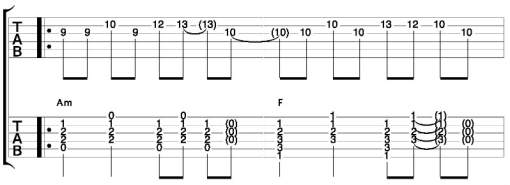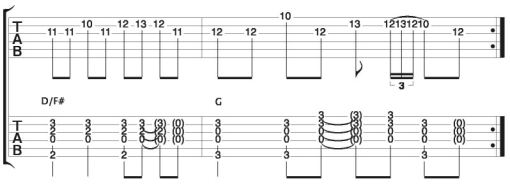Creating unplugged acoustic arrangements of songs is something that many musicians do these days. In fact it has been very popular to do this over the past twenty or so years. Sometimes these acoustic arrangements sound incredible, and other times they sound average at best. It's in the way that you go about creating an unplugged acoustic version of a song that will determine the success you have with it.
To take a song and play it exactly the same on your acoustic guitar will not work out very well for you in most cases. Assuming the song you are creating the acoustic version from features the electric guitar, you need to consider the differences between the two. Sure there are many similarities, but it's in the differences that lie the secrets to creating a great acoustic guitar arrangement of any song.
In this article I am going to share with you some very cool and unique ways you can create your own unplugged acoustic versions of your favourite songs. You need to find ways to compensate for the electric guitar, and other instruments for that matter, if you are creating a solo arrangement of a song.
I can recall really struggling to play electric guitar songs on my acoustic and have them sound decent. The end result was always something that sounded pretty mediocre and this frustrated me for some time.
After carefully watching how other musicians went about creating their unplugged acoustic songs, I discovered that I was just simply playing the song I was creating the version from, note for note on my acoustic guitar and expecting to magically get that "acoustic like" sound. This wasn't going to cut it though, I needed some cool and unique ways that I could compensate for the things that an electric guitar can give you that the acoustic cannot. I also wanted to find ways I could make an acoustic arrangement of a song sound great when I was playing on my own with just the one guitar.
So what are some approaches you may consider for that cool "unplugged" acoustic sound:
To get a bigger, fuller sound with your acoustic version, replace the power chords in the electric song with bar chords and/or open chords. This can be a great way to build the intensity and dynamics in your acoustic song when you don't have the distortion of the electric guitar at your disposal. You don't necessarily have to replace every power chord, it really depends on the context of the song. Whether you go with open or bar chords will also depend on the situation in regard to chord picking, embellishments you would like to include, strumming approaches etc.
A great way to extend the harmony of your chords and create some really nice embellishments, is to include elements of the vocal melody in the progressions of your song. This approach can serve well as an instrumental break within your unplugged song, perhaps replacing an electric guitar solo from the original, or it may simply compliment what the singer is singing at certain parts in your acoustic version. I will show you an example of this a little later on in the article.
A great way to create movement in the chord progressions of your song, is to include parts of the existing bass line of the electric song, in your acoustic version. This is a particularly good approach when playing solo (ie. just you and your guitar) as it will fill out the sound more and substitute well for the bass guitar.
Strumming can have a very percussive effect on your acoustic guitar, providing you with a cool groove, and can be a great tool for compensating for the lack of other instruments, if your are going solo with your unplugged version. It's also great for building intensity and dynamics in your song, again compensating for the electric guitar.
If you try and copy an electric guitar solo onto your acoustic without changing anything, it will often sound weak and lacking due to the differences the two guitars share.
Sometimes it will work, but a lot of times there are some really cool ways you can spice up your acoustic version of the solo, especially if you are playing on your own without a band. Lets have a look at some of the ways to approach soloing in your unplugged acoustic song.
Bending can be difficult to do in certain positions on an acoustic guitar. This is due to the extra tension in the strings compared to the electric. A great substitute for a bend is a slide. Instead of bending to the note, slide to it. It will be a slightly different sound to a bend and will add to the "acoustic" feel of your unplugged song.
It's not always the case that you need to do this though. Sometimes you will find that you can bend the same note from a different string, a higher one preferably, making the bend easier to execute. For example, try bending the 7th fret on the third string of your acoustic guitar. Now try bending the 3rd fret on the second string. Which one is easier?
Double stops are a great tool for soloing with on your acoustic guitar. These are when you play two notes together at the same time. Double stops will add intensity to your solo lines, making things sound bigger, and also compensate well for the lack of distortion and sustain that an electric guitar provides.
A great way to provide some backing for your solo, especially if you are performing on your own, is to drone the lower open strings of the guitar as you play the riffs and licks of your solo. You could think of the solo itself as the right hand of a pianist, and the droning open strings as the left hand which is generally used for accompaniment with piano.
This approach is as simple as it is effective. The droning open strings are effectively taking the role of the bass player and providing you with a backing to your solo, albeit a simple one, but it works very well!
Another great way to provide some backing for your solo is to use what I like to call "chord hits". This is when you play the chord that is happening at the time, between the phrases of your solo. It is very similar to the droning string method, only you can do this in any key as you aren't relying on open strings. Think of it like sketching out the chord progression that is backing your solo, while you play the actual solo at the same time!
A side benefit to this approach is the interplay you get between your solo lines and the chord hits. Without even meaning to, you will come up with some really cool syncopated rhythms between the two as you inject your chord hits.
To make your solo sound even more killer, you can approach your chord hits from a fret above or below providing more movement for the backing. The more ways you know how to play a chord will help to, as you'll more likely have a voicing you can use no matter where you are soloing on the fretboard.
Have a listen to this melody and chord progression:


The melody in the example above could be played by a variety of instruments in the electric song, or it could be the vocal melody for a certain part. It's not really important who or what is playing this melody. It's how we can use it in our unplugged acoustic version that matters. Here is an example of this:

Notice that the melody has come down an octave from the electric song so it can fit in with the chords I am playing in the acoustic version. My aim here is to include elements of the melody rather than try and fit it all in.
This approach could be used in a variety of ways in your acoustic arrangement. It would serve well as an instrumental break between the verses of the song perhaps, or substitute for a solo in the electric version, where you want to do more than simply play the backing chords as they are in the original. It would also sound great filling the gaps between the vocal line, providing some really nice interplay between the acoustic guitar and the vocal.
Download this free ebook and audio to learn more about creating unplugged songs on your acoustic guitar.
Specializing in online acoustic guitar lessons, Simon Candy is based in Melbourne, Australia where he runs his own guitar school.